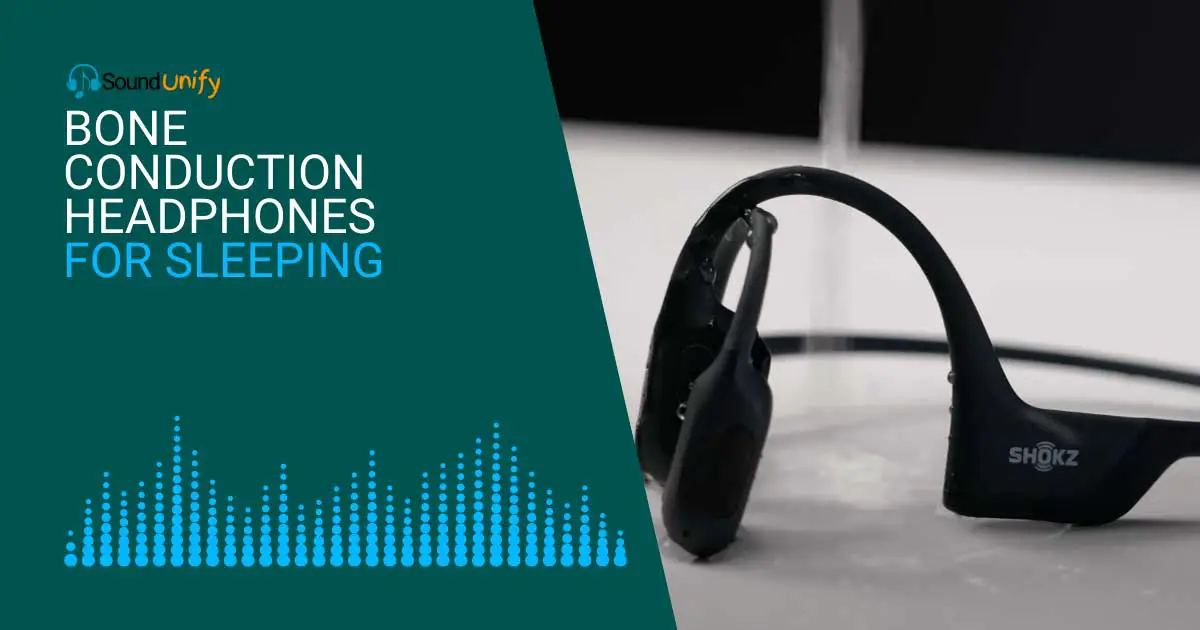Bone-conduction headphones are becoming increasingly popular, especially for me, who wants a good night’s sleep. You can ask why bone-conduction headphones are good for sleep.
Bone-conduction headphones offer many advantages, including adjustable fit, high-quality sound, noise cancellation capabilities, extended battery life, and the capacity to allow one to monitor their surroundings. Consequently, there is sure to be an option that meets the needs of any individual looking for an excellent sleep aid.
But you should be careful to choose your bone-conduction headphone. Because if you don’t find the right one, it can be quite uncomfortable, and the sound quality can be quite poor.
I use many bone-conduction headphones and test them. After testing them, I finalist top 5 headphones. The SHOKZ OpenRun Pro pass all my tests. I recommend this one if your budget is $150+. It will help you get sound sleep and not feel discomfort while sleeping. It is safe to use for a long time. Its secure connection prevents any sound leakage.
In this article, I will explore bone-conduction headphones, how they work, and which features to consider when purchasing them for sleeping.
A roundup of the Best Bone Conduction Headphones for Sleeping:
| Feature | SHOKZ OpenRun Pro | Kimwood HS1 | OUFUNI BCH-B | PURERINA X14 | MOING DG08 |
|---|---|---|---|---|---|
| Battery life | 10 hours | 8 hours | 6 hours | 6 hours | 6 hours |
| Water resistance | IP55 | IP55 | IP55 | IP55 | IP56 |
| Sound quality | High-fidelity audio with deep bass and clear treble | High-fidelity audio with balanced sound | High-fidelity audio with clear and crisp sound | High-fidelity audio with deep bass and clear treble | High-fidelity audio with balanced sound |
| Connectivity | Bluetooth 5.1 | Bluetooth 5.0 | Bluetooth 5.0 | Bluetooth 5.0 | Bluetooth 5.0 |
| Noise Cancellation | Yes | Yes | Yes | No | No |
| Price | Check Here | Check Here | Check Here | Check Here | Check Here |
Top 5 Bone Conduction Headphones for Sleeping

I have used many bone-conduction headphones, and you’ve come to the right place to choose these headphones for sleeping. From budget-friendly options to top-of-the-line models, this list has it all.
1. SHOKZ OpenRun Pro Good For Sleeping
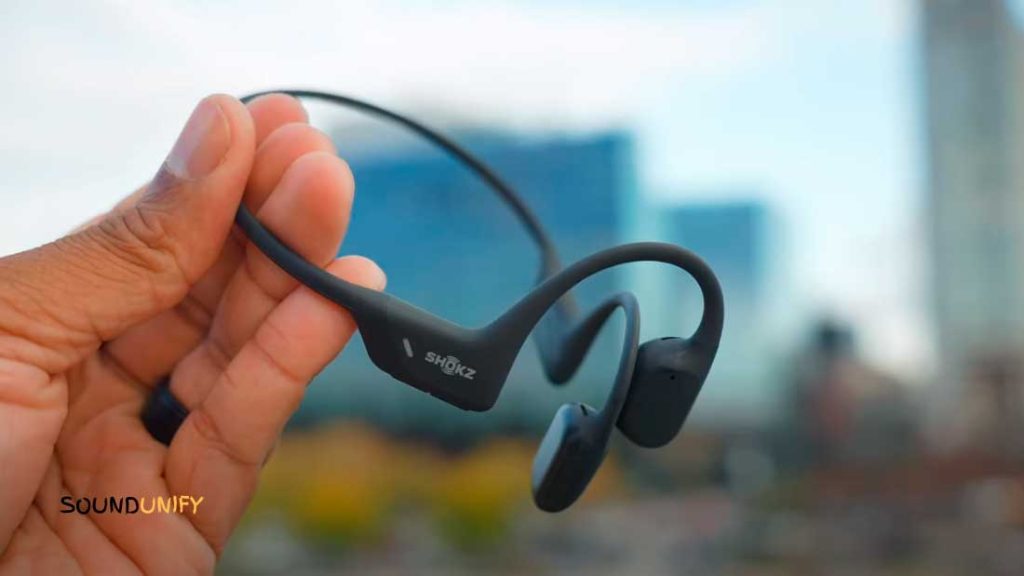
Type: Open-ear | Battery life: 10h | Wireless range: 33ft (10m) | Noise cancelling: Yes | Charging: 1h | Mic & Controls: Yes | Water resistance: IP55 | Weight: 29g
Reason To Buy
- There is a magnetic charging cable with it.
- It allows hearing ambient sounds.
- Use IP55 sweat-resistant technology.
- Allows fast charging.
Reason To Avoid
- It leaks sound.
- It doesn’t have an auto sleep option.
The SHOKZ OpenRun Pro is helpful for various activities. I was excited to try these, as I always struggled with finding comfortable headphones for sleeping.
The open-ear comfort is unlike any other headphones I’ve tried. The bud-free design eliminates the discomfort of traditional in-ear headphones. Its Shokz headband keeps them securely in place during sleeping.
Its previous model had a “disconnected from Bluetooth” beep that beeped continuously. But this model eliminates this annoying sound. It also doesn’t have a button press beep tone, as in the previous model.
But what sets these headphones apart is the premium sound quality. The Shokz TurboPitch technology delivers clear, powerful audio and rich bass. It is very lightweight. So I don’t have any problem sleeping after wearing it, nor do I feel any weight on my head.
On top of all that, the battery life is impressive. I can use it for 10 hours continuously. So I don’t have to go to sleep thinking the battery might die at any moment.
2. Kimwood HS1 Bone Conduction Headphones
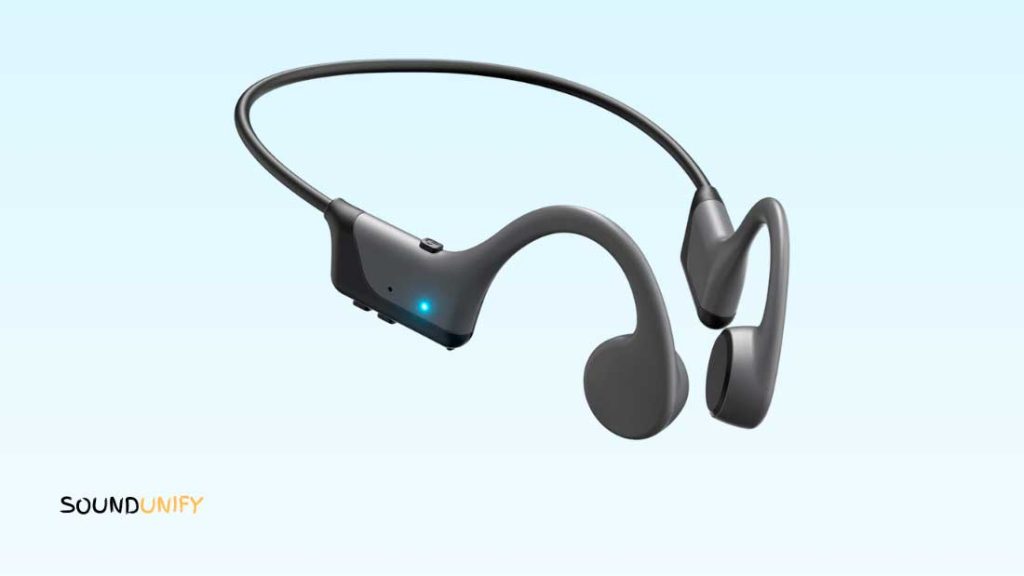
Type: Open-ear | Battery life: 8h | Wireless range: 33ft (10m) | Noise cancelling: Yes | Charging: USB Type-C | Mic & Controls: Yes | Water resistance: IP55 | Weight: 29g
Reason To Buy
- It takes only 1-2 hours to recharge fully.
- Ultra-lightweight and comfortable design.
- Flexible and durable wraparound titanium frame.
- IP55 Certified Waterproof, perfect for sports enthusiasts.
- Ensures less vibration with a louder volume.
Reason To Avoid
- Music and call volume are in different control channels.
The Kimwood open-ear headphones are another bone-conduction headphone I am extremely impressed with. Bone conduction technology is a game-changer for me. It is also IP55 Certified Waterproof, which is extremely helpful for me when running or cycling.
One of the things I love most about these headphones is the ultra-lightweight design. At only 29g, they are incredibly comfortable to wear, even when I am sleeping. It wouldn’t sleep out from my head; I don’t feel any weight. So cool, right?
I can enjoy my 8 hours of sleep with the music I want because I don’t have to worry about charging the battery. It is a major plus for me. The Type-C fast charging is also a great feature – it’s safe and stable.
It also has the flexibility of a 10-minute quick charge option. That provides an additional 1.5 hours of battery life, saving me time in the long run.
One of my favorite features of the Kimwood headphones is their completely wireless. Its advanced Bluetooth 5.0 technology is super beneficial for me to use anywhere, especially in the gym. I can also use it in my office on any video conference as it has noise-canceling technology.
I also like the attention to detail in the package. It comes with 1 Type-C Fast Charging Cable and 2 Sponge Earplugs. Its Manual makes it easy to get started using the headphones. The 90-day refund and 2-year warranty also give me peace of mind.
Overall, the HS1 bone conduction headphones to anyone looking for a high-quality, comfortable, versatile pair. They are perfect for sports enthusiasts and business people who often work from home and hold video conferences. The package is also an excellent gift for your lover, family, or friends.
3. OUFUNI BCH-B Bone Conduction Headphones
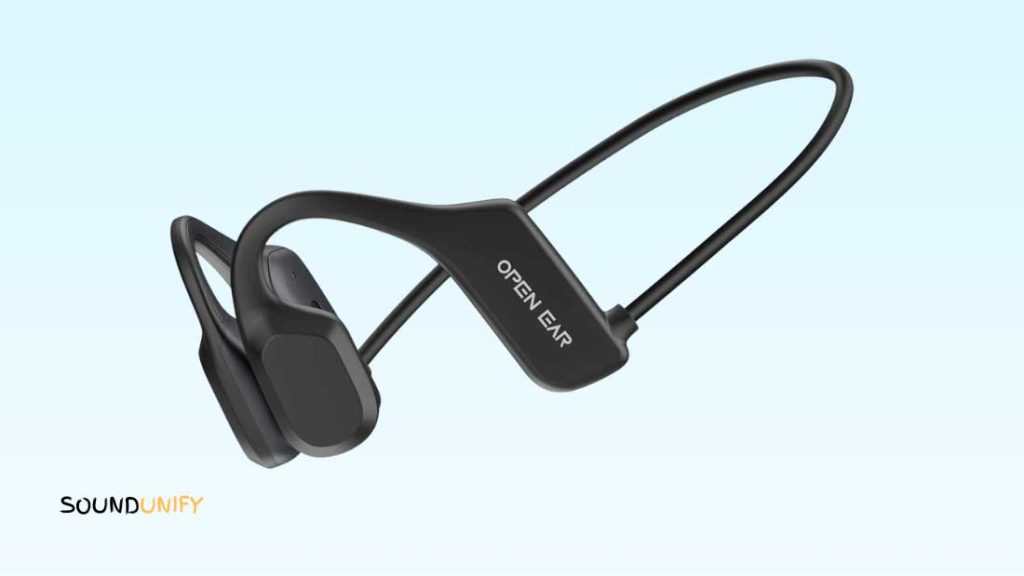
Type: Open-ear | Battery life: 6h | Wireless range: 33ft (10m) | Noise cancelling: Yes | Charging: 5 mint for 1h | Mic & Controls: Yes | Water resistance: IP55 | Weight: 29g
Reason To Buy
- It comes with a guide to measure ear size for a perfect fit.
- Extra-long battery life of 6 hours and fast charging option.
- Waterproof and sweatproof perfect for workouts.
- Easy-to-use multifunctional buttons.
- Comfortable to use with glasses.
Reason To Avoid
- Not suitable for swimming.
OUFUNI Bone Conduction Headphones have been an incredible asset to my sleep routine. I was delighted by their size information and materials when I looked closely at their specifications.
The headphones are as light as a feather, making them comfortable even after long hours of listening. They feature a soft leather headband and ear pads, and they tell you the exact distance between your ears before taking the plunge and buying them.
But the best feature of these headphones has to be their sound quality. With integrated ENC noise-canceling chips, they deliver balanced audio with robust volume. And although the headphone’s open-ear design means that I can still hear my surroundings, I can still lose myself in my music.
Furthermore, the long battery life ensures I can enjoy my sleep uninterrupted, as I won’t risk running out of power halfway through the night. These headphones last about an hour after a 5-minute magnetic fast charging.
Moreover, their waterproof and sweatproof design allows me to use them without fear of them getting damaged or breaking down due to sweating during my sleep.
All this at a very affordable price makes them a product worth investing in. They have been a great companion on my journey to better sleep, and I could not recommend them more highly.
4. Purerina Bone Conduction Headphones
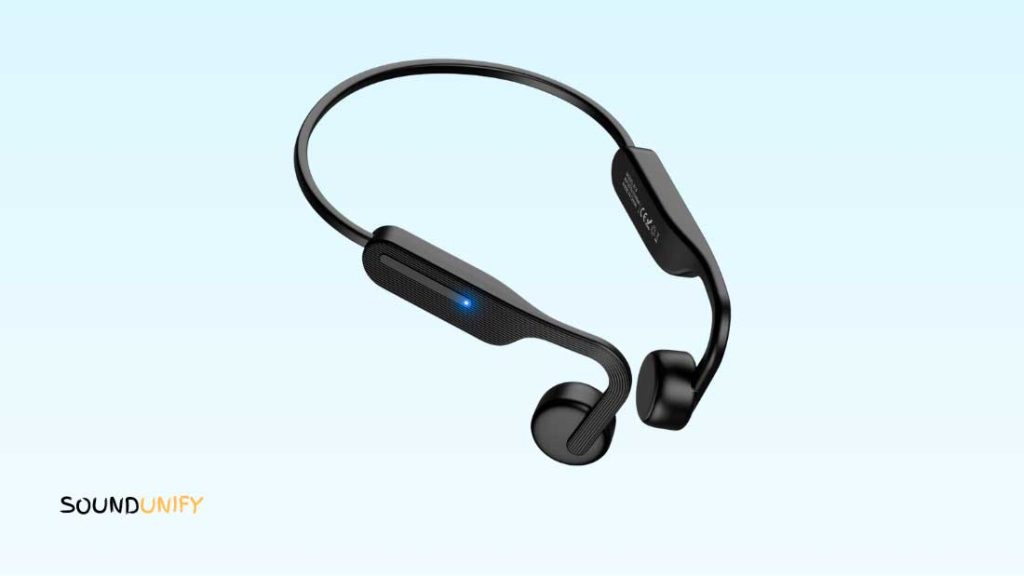
Type: Open-ear | Battery life: 10h | Wireless range: 33ft (10m) | Noise cancelling: No | Charging: 2h | Mic & Controls: Yes | Water resistance: IP55 | Weight: 30g
Reason To Buy
- You can bend it without having deformation.
- It comes with a pair of earplugs.
- It also has an adjustable strap for comfort fit.
- Don’t leak sound at all.
Reason To Avoid
- It will only give 6 hours of battery time if you use less than 70% of the volume.
My Purerina Bone Conduction Headphones have become a daily companion since I bought them. What I love most about this headphone is that it needs no battery and is wireless. So I don’t have to be concerned about anything.
Plus, its Bluetooth 5.0 chip makes the connection stable and fast. I never have to worry about missing music because of an unstable connection. Its soft silicone pad is very comfortable for long use. I can wear it all night painlessly and in a deep sleep.
I also like to work out a lot, and these headphones are more than great for my needs. The titanium memory metal frame keeps the headset firmly in place when I’m running or biking. It’s IP55 certified, which means it’s dust and water-resistant and perfect for outdoor and indoor exercises.
Long battery life is necessary; I can get up to 6 hours of continuous music and calls with one charge. And if I’m in a hurry, I can fast-charge in 5 minutes. It can also stand by for up to 240 hours. That has been a true lifesaver on multiple occasions.
Once paired with my mobile phone, its audio quality is clear. I can make calls with my mobile and have a conversation without hassle. I will give it an extra point for that.
5. MOING DG08 Wireless Bone Conduction Headphones
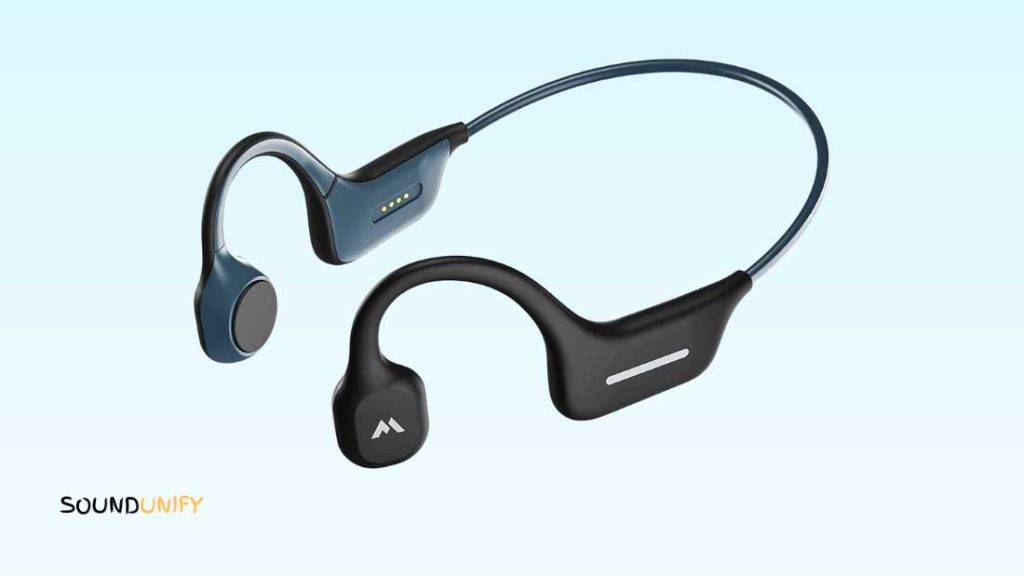
Type: Open-ear | Battery life: 6h | Wireless range: 33ft (10m) | Noise cancelling: No | Charging: 1.5h | Mic & Controls: Yes | Water resistance: IP56 | Weight: 29g
Reason To Buy
- Latest QCC chipset and technology for premium sound quality.
- Reflective strips provide visibility at night.
- Can resist most vigorous exercises.
- Only one button for all the activities like play, pause, answer calls, etc.
Reason To Avoid
- The sound may seem low to some people.
The MOING DG08 Wireless Bone Conduction Headphones convert sound into mechanical vibrations of different frequencies. It also ensures hearing of ambient sounds. It helps me while I am running or exercising.
It has an ergonomic design to ensure maximum comfort even when I wear it for a long time. It gives me 6 hours of battery life, enough for a good night’s sleep.
When I take calls, it ensures crystal clear sound, and with built-in CVC 8.0 microphone makes the conversation enjoyable. I can use it outdoors without hesitation as it is dust and moisture-proof. I also use it in the gym because it has an IP56 waterproof rating and is sweatproof.
If you are looking for headphones that provide sound quality and safety, I recommend you use them. It has a long-lasting battery that you can continuously use for 5-6 hours. So you don’t have to charge them very often.
The combination of excellent sound quality and safety makes these headphones a perfect choice for anyone looking to listen to music while staying aware of their environment.
How Do Bone Conduction Headphones Work?
Bone conduction headphones send vibrations through the bones in the skull directly to the cochlea, the part of the inner ear responsible for interpreting sound.
These vibrations bypass the outer and middle ear, which filter and amplify sound before it reaches the cochlea.
The technology used in bone-conduction headphones is similar to that used in bone-conduction hearing aids. A small transducer, typically made of a material such as titanium, is placed in contact with the bone behind the ear.
This transducer converts the electrical audio signals into mechanical vibrations, then transmitted through the bone to the cochlea.
The main difference between bone conduction and traditional headphones is that traditional headphones block out external sound while producing sound at a higher volume.
On the other hand, you can remain aware of the outside world while still enjoying the audio content using bone-conduction headphones.
This makes them ideal for people who want to listen to something while still being able to hear what’s happening around them. They are typically lighter and more comfortable than traditional headphones, which are great for sleeping.
Features To Consider When Purchasing Bone Conduction Headphones
Before purchasing bone-conduction headphones for sleeping, there are a few features to consider.
1. Comfort Level & Fit
Bone conduction headphones sit directly on the skull. So, proper fitting is the most important part. It will ensure comfort and sound quality.
Good-quality bone-conduction headphones have soft, padded ear cups and an adjustable headband to ensure a good fit.
That will ensure the device stays firmly in place and doesn’t cause discomfort or move around during sleep. You can also find some headphones with foam or gel-based ear tips.
That will also fit your ear while blocking out ambient noise. So try to find a comfortable pair to wear for a long time.
2. Noise Reduction Capabilities
When you want a sound sleep, then the noise reduction capability of a headphone is a must. Bone conduction headphones have advanced noise-canceling technology to minimize external noise and maximize sound quality.
Look for these features to ensure good-quality audio while being conscious of your surroundings.
3. Sound Quality
The sound quality of the headphones is another crucial factor to consider when choosing a pair for sleeping. Your headphones should have enhanced bass and clear highs to enjoy the audio content with clarity and accuracy.
Look for headphones with a wide frequency response and a high signal-to-noise ratio. That will ensure that you are getting the best possible audio experience.
4. Battery Life
It’s essential to consider the battery life of any device you purchase. Many bone-conduction headphones rely on a battery to power them. Look for a pair with long battery life, ideally at least 6 hours of continuous use.
That will ensure that you can use your headphones throughout the day without stopping to recharge them constantly.
5. Connectivity & Control Options:
Bone conduction headphones typically connect to a device via Bluetooth. Wi-Fi and Bluetooth allow you to stream audio content without wires while giving you control of the headphones from your mobile device.
Many headphones come with touch-sensitive control buttons and voice commands, making them even easier to use while sleeping.
Look for a pair that supports the latest Bluetooth version for the best sound quality and stable connection.
6. Durability
If you want to use them while sleeping, durability is important when buying a pair of headphones. Look for headphones made of high-quality materials with reinforced cables.
Moreover, many brands provide warranties for their products. That will ensure that your headphones last for years.
7. Brand Reputation & Customer Support
Brand reputation is essential when purchasing any product, and bone-conduction headphones are no exception. A reputable brand will ensure that you are getting a quality product.
So, always check the brand reputation and customer support when researching and buying headphones.
That often indicates their quality and performance. That helps ensure that any problems or queries they will quickly and effectively handle it.
8. Price & Overall Value for the Money
Always consider the price and overall value for money when looking for the perfect headphones for sleeping.
Look for headphones that offer your desired features at a price that fits your budget. That doesn’t necessarily mean you must opt for the most expensive headphones.
Consider the features, brand reputation, and customer support to ensure you are getting good overall value for the money.
9. Compatibility with Assistive Hearing Devices:
Some bone conduction headphones are compatible with assistive hearing devices such as cochlear implants and hearing aids. That is a helpful feature for people with hearing loss.
10. Water Resistance:
If you plan to use your bone-conduction headphones while doing sports or other outdoor activities, looking for a water-resistant pair is a good idea. That will ensure your headphones can withstand sweat and rain and last longer.
How to Wear Bone Conduction Headphones Comfortably When Sleeping?
1. Position the headphones correctly
Positioning the bone conduction headphones correctly is crucial in ensuring comfort, especially when you plan to wear them while sleeping. Here’s an in-depth guide on how to do it:
- Identify the Vibrating Pads: Bone conduction headphones have vibrating pads that transmit sound through your bones. These pads are the key components that need to be positioned correctly.
- Locate Your Cheekbones: The pads should be placed on your cheekbones, just in front of your ears. You can feel your cheekbones with your fingers to find the right spot. This positioning allows the vibrations to travel directly to your inner ear.
- Align the Pads with Cheekbones: Gently align the vibrating pads of the headphones with your cheekbones. Ensure they are not placed on the soft part of your cheeks, which can reduce sound quality and cause discomfort.
- Adjust the Headband: Most bone conduction headphones come with an adjustable headband. You’ll want to ensure that the band is neither tight nor loose. Too tight can cause pressure and discomfort; if it’s too loose, the headphones may shift during sleep.
- Check the Angle: Some models allow you to adjust the angle of the pads. If that’s the case with your headphones, you may need to experiment to find the most natural and comfortable angle.
- Test the Sound: Once you’ve positioned the headphones, playing some audio to ensure you can hear it is a good idea. You may need to reposition the pads if the sound is muffled or distorted.
- Consider Your Sleeping Position: If you’re a side sleeper, you may need to make further adjustments to ensure the headphones don’t press uncomfortably against your head when lying down. Look for a position that feels comfortable when lying on your side.
- Reevaluate as Needed: It’s not uncommon to need a few nights of adjustment to find the perfect position. Don’t be afraid to make small changes each night until you find what works best for you.
2. Use a sleep mask or pillow
A sleep mask or a specially designed pillow can enhance the comfort of wearing bone conduction headphones while sleeping. Here’s an in-depth look at how to incorporate these accessories:
Using a Sleep Mask with Bone Conduction Headphones:
- Select the Right Sleep Mask: Choose a soft, comfortable sleep mask that doesn’t pressure the headphones. Some sleep masks are designed with extra space around the ears, which can be ideal for this purpose.
- Position the Headphones First: Before putting on the sleep mask, ensure the headphones are correctly positioned and the tension is adjusted to your comfort.
- Place the Sleep Mask: Carefully put on the sleep mask, ensuring it doesn’t press down on the headphones or shift their position. The mask should fit comfortably over your eyes without interfering with the headphones.
- Test for Comfort: Move around to mimic your sleeping movements and ensure the mask and the headphones stay in place without discomfort.
- Adjust as Needed: If you feel any pressure or discomfort, you may need to adjust the positioning of the mask or the headphones.
Using a Pillow with Bone Conduction Headphones:
- Choose the Right Pillow: Look for a pillow that accommodates the headphones, such as a cutout or indentation where the headband can rest. Memory foam pillows can also conform to the shape of the headphones.
- Position the Headphones: As with the sleep mask, ensure the headphones are correctly positioned and adjusted before lying down.
- Lie Down Carefully: Be mindful of the headphones and pillow position. If you’re a side sleeper, ensure the headphones don’t press uncomfortably against your head.
- Test and Adjust: Spend a few minutes lying in your usual sleeping positions to ensure comfort. Adjust the pillow or headphones as needed.
- Consider a Specialized Pillow: If you find regular pillows uncomfortable with the headphones, you might consider investing in a pillow specifically designed for use with bone conduction headphones.
3. Experiment with different sleeping positions
Experimenting with different sleeping positions is essential when using bone conduction headphones, as it can significantly impact comfort and sound quality. Here’s an in-depth guide to help you find the best sleeping position:
- Understand Your Natural Sleeping Position: Most of us have a preferred sleeping position, such as on our back, side, or stomach. Recognize your natural position and start your experimentation from there.
- Back Sleeping Position:
- Advantages: This position often works well with bone conduction headphones, as there’s no pressure on the sides of the head.
- Considerations: You may need a pillow with a cutout or indentation for the headband to avoid pressure on the back of your head.
- Tips: Ensure the headband is tight, as lying on it can increase tension.
- Side Sleeping Position:
- Advantages: Many find this the most comfortable sleeping position, but it can be challenging with headphones.
- Considerations: Look for headphones with a flexible or thin band, and use a soft pillow that can conform to the shape of the headphones.
- Tips: You may need to slightly adjust the position of the headphones when lying on your side to avoid pressure on the ear or jaw.
- Stomach Sleeping Position:
- Advantages: This position usually doesn’t pressure the headphones but may not be comfortable for everyone.
- Considerations: Ensure the headphones are secure, as this position might cause them to shift.
- Tips: A flat or soft pillow can help maintain the position of the headphones.
- Experiment and Adjust:
- Try Different Positions: Spend a few nights trying different positions to see what feels most comfortable with the headphones.
- Adjust the Headphones: You may need to reposition the headphones slightly as you change sleeping positions.
- Use Accessories: Consider using a sleep mask or specialized pillow to enhance comfort in different positions.
- Listen to Your Body:
- Comfort is Key: Comfort is the most critical factor, so listen to your body and adjust as needed.
- Don’t Force a Position: It’s okay to revert to what feels natural if a position feels uncomfortable with the headphones.
FAQ
Can you wear bone conduction headphones while sleeping?
Yes, you can wear bone conduction headphones while sleeping. Turning the volume down low and ensuring the fit is comfortable to avoid any discomfort is recommended.
Are bone conduction headphones safe for sleeping?
Yes, bone conduction headphones are generally safe to use while sleeping. It is essential to follow the manufacturer’s instructions and ensure the volume and fit are low to avoid discomfort.
What are the benefits of using bone conduction headphones for sleeping?
The main benefit of using bone conduction headphones while sleeping is allowing users to listen to music while protecting their ears from the environment’s noise. They are often lighter and more comfortable than traditional headphones. It’s making them easier to wear while sleeping.
Are bone conduction headphones comfortable to wear while sleeping?
Yes, bone conduction headphones are usually very comfortable to wear while sleeping. It is essential to ensure the fit is secure and snug to avoid discomfort. Keeping the volume comfortable will ensure the user is not disturbed while sleeping.
Are there any downsides to using bone conduction headphones for sleeping?
The main downside to wearing bone conduction headphones for sleeping is that there is a risk of discomfort if the fit is not secure or the volume is too loud. It is best to keep the volume low and ensure a secure fit to minimize the risk of any negative effects.
Final Words
Bone conduction headphones are a unique and innovative solution for those looking to improve their sleep quality and stay aware of their surroundings.
With the ability to transmit sound through the bones of the skull, these headphones offer several benefits over traditional headphones.
From increased awareness and improved sleep quality to reduced ear pressure and accessibility for people with hearing loss, bone conduction headphones offer something for everyone.
You can try SHOKZ OpenRun Pro headphones to improve your sleeping condition. Their water-resistant feature and compatibility with assistive hearing devices make them suitable for sports and outdoor activities and for those with hearing loss.
James Dimento is a Chief-in-Editor of SoundUnify. He is a headphone enthusiast and creative writer passionate about audio technology. He has three years of experience writing about headphones and sound quality and is responsible for creating reviews and taking care of all administration.
